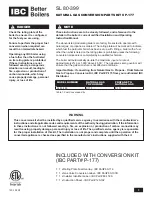
Page
19
of
34
L. Filling the Boiler with Water
Inspection:
Before filling, inspect the pump shaft by removing the large silver screw to expose the
top of the shaft and turn back and forth with a screw driver to make sure the shaft was not broken
during shipping.
Broken shafts are not covered under warranty unless found and noted before
installation and startup. Also read maintenance section in full.
Once all piping connections are complete, flush about 20 gallons of water into the float stack and
drain, repeating until it comes out clean. Close drain valve and pour Nature’s Comfort boiler
treatment in –
required for warranty
. Fill the boiler with a hose through the float stack or if you
have installed a fill line, open the valve and allow it to fill, stopping once the float starts to rise.
Use water that is softened and has low iron content if possible for maximum boiler and pump life.
Do not start circulation pump until boiler is FULL and the impeller and bearings have been
primed!
After filling, remove the top screw on the pump until a steady stream of water flows and all
air has been purged. Being a wet-rotor unit, if the pump runs dry at all, it will seize up as the
bearings rely on lubrication from the water.
See maintenance section for full details on pump
operation and care.
During the first heating cycle the water might expand and overflow. This is normal and will occur
anytime too much water has been added. Open the drain valve to keep the float indicator at the
bottom of the rubber cap. Any higher than this and hot water may push the float out and also cause
scalding water to spill out. (Over-fill when boiler is shut off and not in use)
After water has circulated for 1 hour, test Nitrite level to assure required 1,000-1,500ppm and
add treatment if below this level. Submit a water sample to your dealer or Nature’s Comfort
for official warranty Nitrite testing and also once a year thereafter. REQUIRED! See warranty
for full details.
M. Float Level
After priming and starting the circulation pump and bleeding the heat exchanger (see next section),
let the boiler heat up and run for 24 hours then top off the water if needed. The ideal water level is
at the beginning of a heating cycle for the level indicator to be at the bottom of the rubber cap. The
water level will rise and fall during operation as water expands and contracts with temperature
changes. Be sure to keep the boiler full of treated water at all times including through the summer
as this will keep the boiler free from corrosion and when in use, from overheating causing
circulation pump failure.
N. Bleeding the Heat Exchangers
With the pump running (prime and flush bearings first!), simply close a valve on the return side, hold
for 1 second then open quickly. Repeat the procedure four times or until you cannot hear air rushing
through the line.
O. Pre-conditioning Rope Seals
Option 1: (Good) Wet the rope seals with WD-40 before firing the boiler to keep prevent hardening
from smoke and creosote and re-apply 1 or 2 times during the heating season or as needed.
Option 2: (Better) Purchase a tube of high temperature caulk from your dealer or Nature’s Comfort
and lay a bead of caulk on the impression of the door jamb in the rope seals, placing a 2” strip of
wax paper over them. Over-extend the latch open and bounce the door/ash pan closed, then leave
open to fully cure before starting a fire to get a custom seal. Once cured, wet the rope seals with
WD-40 to prevent hardening from smoke and creosote and re-apply 1 or 2 times throughout the
heating season or as needed.
Summary of Contents for NCB-120-COAL
Page 2: ......
Page 4: ......
Page 18: ...Page 18 of 34 ...
Page 32: ...NCB Built Like A Tank With Laser Precision Page 32 of 34 ...
Page 34: ...NCB Built Like A Tank With Laser Precision Page 34 of 34 ...
















































